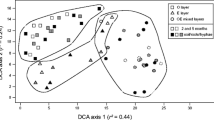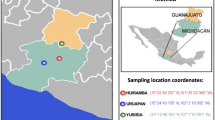Abstract.
The effects of seed inoculation with the Pseudomonas fluorescens strains F113lacZY [a genetically marked biocontrol agent producing the anti-fungal agent 2,4-diacetylphloroglucinol (DAPG)] and F113G22 [a genetically modified (GM) derivative strain of F113lacZY incapable of producing DAPG] on associated nematode communities were investigated over 17 days of plant growth. Plant growth measurements and colony forming unit counts (CFU) derived from rhizosphere soil indicated only small and transient perturbations as a result of introductions of the GM bacteria. Total nematode numbers were increased significantly in the rhizosphere of inoculated plants compared with the non-inoculated control treatments. These increases were mainly due to increases in bacterial feeding nematodes. This indicates that inoculation with the GM P. fluorescens strains induced high bacterial growth rates in the rhizosphere of plants inoculated with these strains. No indication of greater root colonisation by fluorescent Pseudomonas spp. could be found using CFU counts on Pseudomonas-selective media. Numbers of fungal feeding nematodes decreased initially, probably as a result of lack of intact hyphae in the soil. However, inoculation with the two different GM P. fluorescens strains resulted in a rapid recovery of fungal feeding nematode populations, whereas in the non-inoculated control populations of fungal feeding nematodes remained small. This result is surprising as one of the strains (F113lacZY) produces the anti-fungal agent DAPG and it would be expected that this agent would result in a decrease in fungal activity.
Similar content being viewed by others
Author information
Authors and Affiliations
Additional information
Electronic Publication
Rights and permissions
About this article
Cite this article
Brimecombe, M.J., Leij, F.A. & Lynch, J.M. Nematode community structure as a sensitive indicator of microbial perturbations induced by a genetically modified Pseudomonas fluorescens strain. Biol Fertil Soils 34, 270–275 (2001). https://doi.org/10.1007/s003740100412
Received:
Issue Date:
DOI: https://doi.org/10.1007/s003740100412




